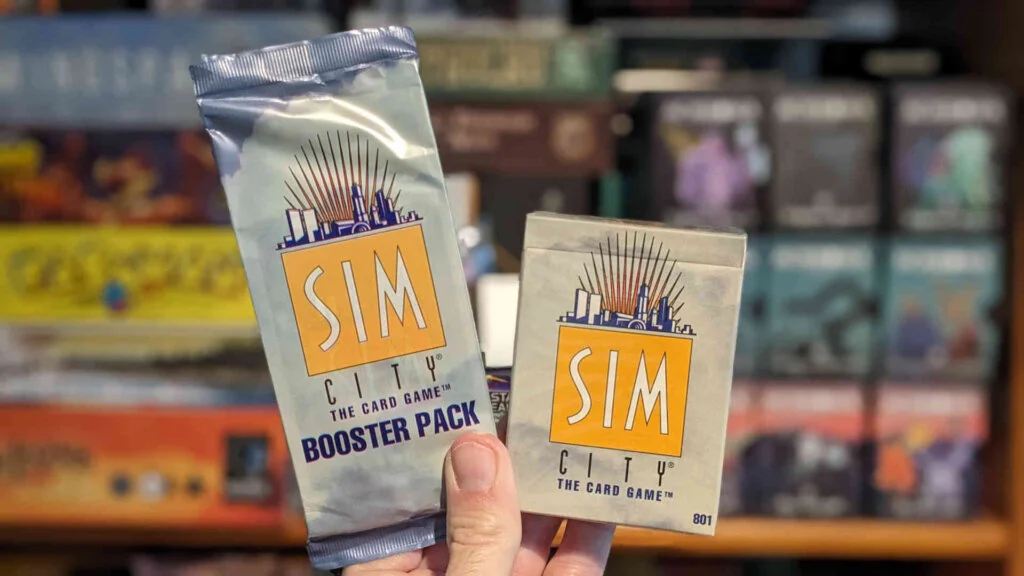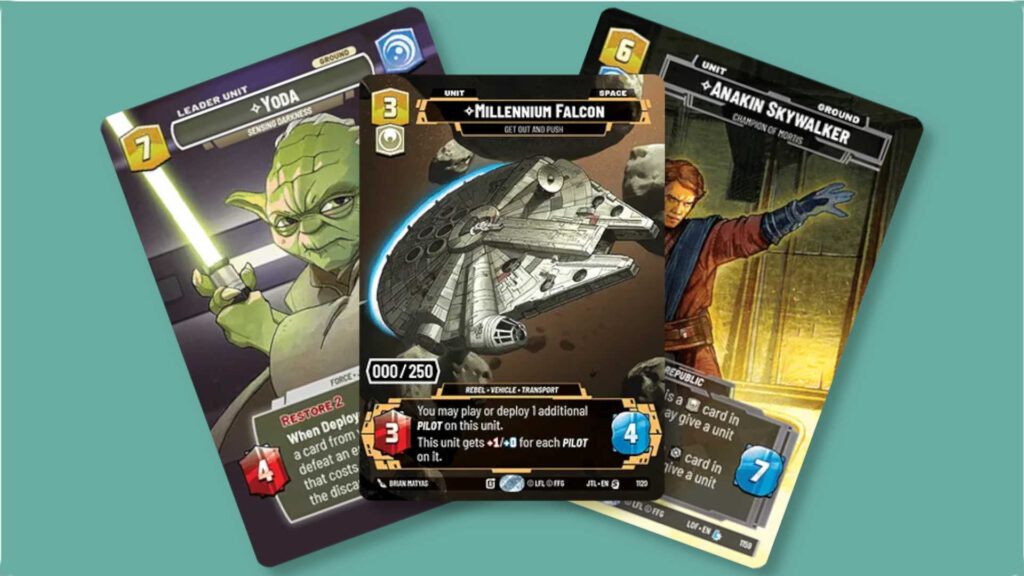Though Will Wright began development on Sim City in 1985 on the Commodore 64, it’d take four years before it’d be completed and picked up by publisher Maxis; it’d been rejected numerous times by companies who didn’t believe it’d sell, as a game which couldn’t be won or lost in any traditional sense.
Arriving first on the Commodore Amiga and Macintosh computers in 1989, it was soon followed by PC and Commodore 64 versions, before launching on just about every contemporary computer platform over the next few years.
It even, perhaps most notably, arrived on the SNES, with an acclaimed version developed and published by Nintendo themselves (which, incidentally, is still one of my favourite video games to this day).
With all of these ports being hits on their individual platforms, it’s fair to say that Sim City was a massive commercial success.
It was critically acclaimed too, winning numerous industry awards in the late 80s and early 90s.
Sim City’s critical and commercial reception led to Wright and publisher Maxis kickstarting an entire ‘Sim’ series of spin-offs and sequels; even The Sims, EA’s hugely successful life simulation franchise, began life as a Sim City spin-off. The Sims 2 could even share its residents and neighbourhoods with Sim City 4!
It’s no surprise, then, that in the 90s, Sim City also made it beyond the confines of the digital world and onto the tabletop, with Sim City: The Card Game.
Table of Contents
ToggleSim City: The Card Game – The Basics
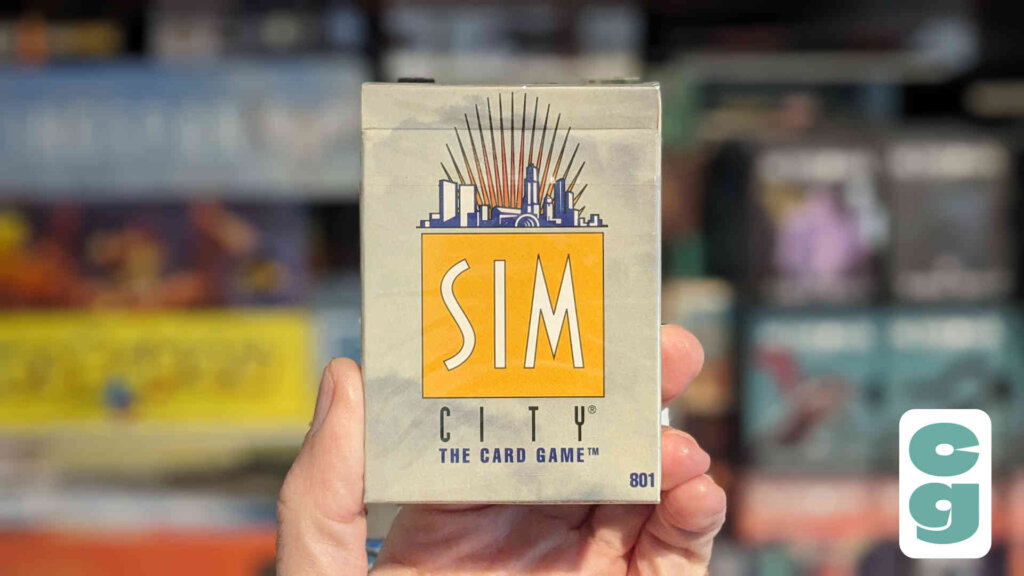
Arriving in 1995, Sim City: The Card Game was published by Mayfair Games.
It was a collectable card game (or CCG), with the initial set containing a huge 517 cards.
154 of these were double length; these weren’t available in the starter sets and instead could only be found in the game’s booster packs, which contained 15 cards overall, but only one long card per pack.
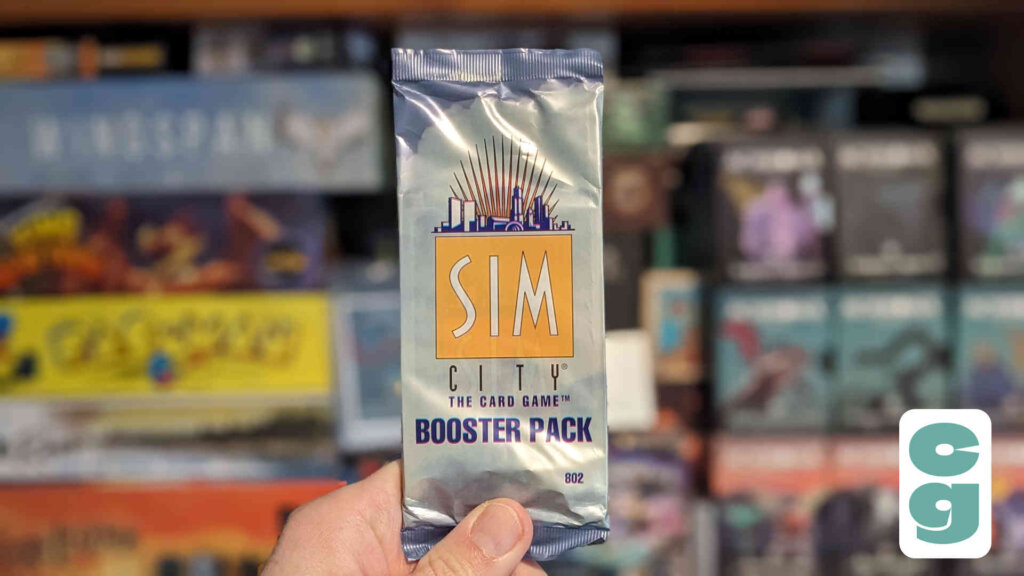
With each of the long cards being ultra rare, it was incredibly difficult to acquire a full set; along with the difficulty in collecting the unique long cards, there were so many standard sized cards (363 of them) in the set that it was also pretty tough even to build up a decent collection of those too.
The cards themselves all feature photos in lieu of art; these show actual buildings and people, representing different city blocks and council officials (the Mayor card actually featured the head of Mayfair Games and co-designer of this very game, Darwin Bromley).
Interestingly, Sim City: The Card Game can be played as a solitaire game, though the packaging over-ambitiously states that it can be played by up to 20 players; it’s hard to believe anyone having the space, time or card collection to support any more than four players at a time, however.
In order to win, you just need to be the first player to earn $250.
So what is Sim City: The Card Game actually like to play? Let’s take a closer look at the cards and mechanics of the CCG.
How To Play Sim City: The Card Game
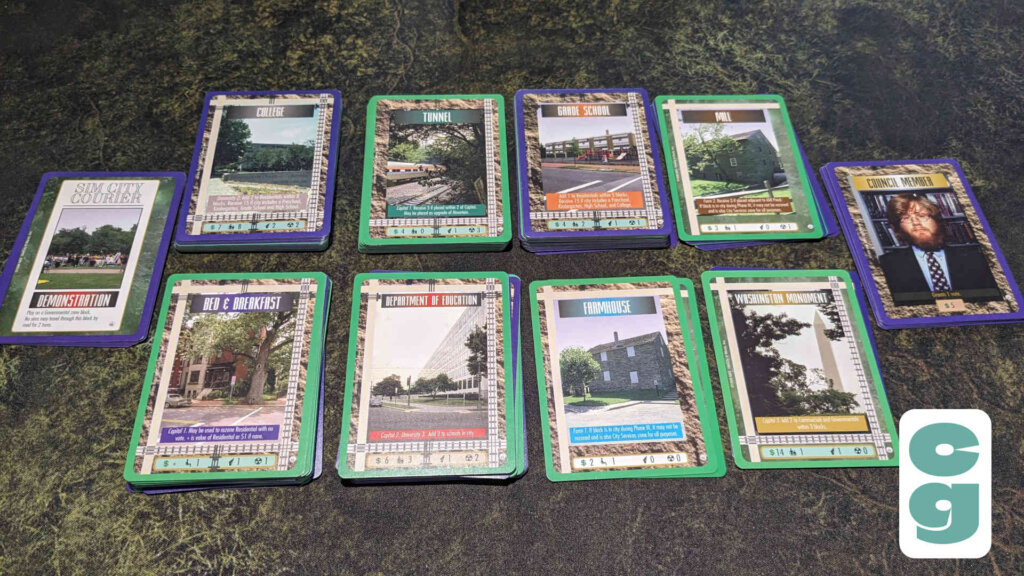
In the above image, you can see cards sorted into their different zone types, as well as Event cards on the leftmost pile and Council official cards furthest to the right.
There’s an awful lot of different elements on the cards in Sim City, and it has to be said that it’s not exactly the most intuitive, aesthetically pleasing or even user friendly game.
Many of the rules that govern where and when a card can be played are determined by different colours, on different parts of the card.
The Cards Of Sim City
The card’s type is shown in the colour of the card’s title and ability box, but not all cards have these secondary text boxes in addition to the title; with so many of these colours, it’s also the case that several of them look a little too similar to each other at first glance.
That problem is exacerbated by the inclusion of a black and white rule book, so any examples given can’t properly be compared to the actual cards in terms of their colour classification!
What also doesn’t help is that there’s a further way that cards are classified by colour; the icon box has a coloured background which tells you which stage of the game the card can be played in.
Cards also have a coloured border and different background image in addition to the central photo; neither of which seem to have any effect on gameplay or card classification at all – adding further, unnecessary confusion!
It’s a shame that the cards are needlessly busy and overcomplicated, because from a gameplay point of view, turns in Sim City: The Card Game couldn’t be simpler.
Taking A Turn In Sim City
There’s no breakdown or turn summary needed here; in fact, each player’s turn is essentially just placing a card from their hand and then scoring it.
Naturally, there are further wrinkles when it comes to actually scoring a card, based on where the card is played and what blocks around it may give it extra bonuses (or perhaps penalties!).
This can be a little time consuming and confusing, but with multiple players keeping an eye on scores, bonuses and penalties, you can all share the load of keeping track of what a card is worth when played, as well as how it affects everything else!
Placing Cards In Sim City
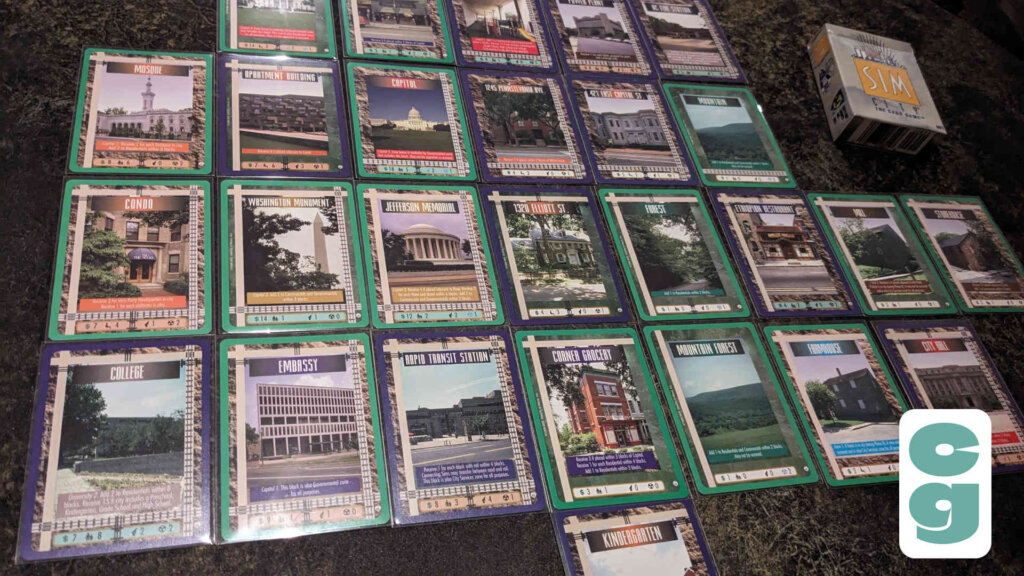
One of the most important rules concerns Sims (yep, those Sims; the ‘simulated citizens’ of Sim City!) being able to travel to certain blocks in order for them to be played.
Residential blocks provide Sims and most other types of block require Sims to be able to get to them, in order for them to be placed.
Travelling to a new block can be done by road or rail, but never both (unless connected by a Rapid Transit Station card, which allows Sims to transfer between road and rail at that point).
Other icons on a card include crime and pollution, but these tend to only come into play much later in the game, if at all.
Otherwise, Sims aside, the most important icon is the $; this one tells you how many $ you earn for placing the card, though there may be bonuses based on its placement near other blocks of the same type, or extra $ provided by other card text.
There’s some issues with how complicated bookkeeping can get when numerous cards build up various bonuses across the map (and the rules do a terrible job of explaining how certain point scoring opportunities work) but at its simplest, you’ll just need to place a card and then earn the dollar amount it shows.
There’s also Event cards that can be played, which have different effects on the cards in play; these may utilise the aforementioned crime or pollution numbers, for example, or even destroy a building in your city.
The Phases Of Your City
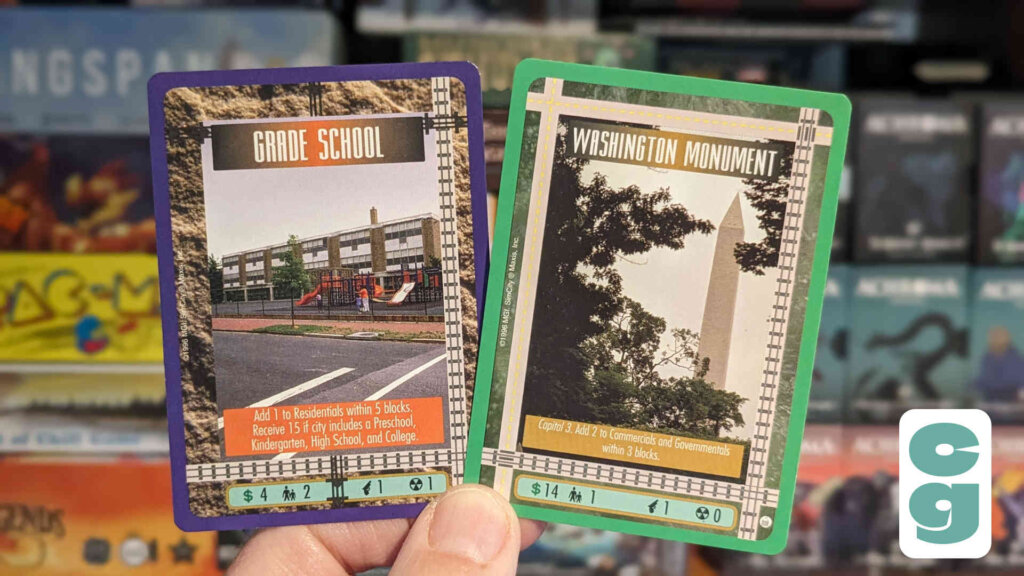
At the outset, only cards with a white icon background can be played; this is because all cities in Sim City begin with Phase I, as a Settlement.
Once your city has double the number of Sims provided as there are players (or a minimum of 8 Sims for less than 4 players), it becomes a Town and can move to Phase II, signified by green icon box cards. Both of the cards in the image above have the green icon box, so they can be used from Phase II onwards.
Phase III, in which the Town becomes a City, begins once a player places a Power Plant; this then triggers the availability of tan coloured cards and the player in question becoming the Mayor (as well as the formation of the City Council, which we’ll come to in a bit!).
Finally, Phase IV sees your flourishing city becoming a Metropolis; this not only allows the placement of cards with a pink icon box, but also allows the use of special, Ultra Rare double length cards that function as two city blocks.
The City Council
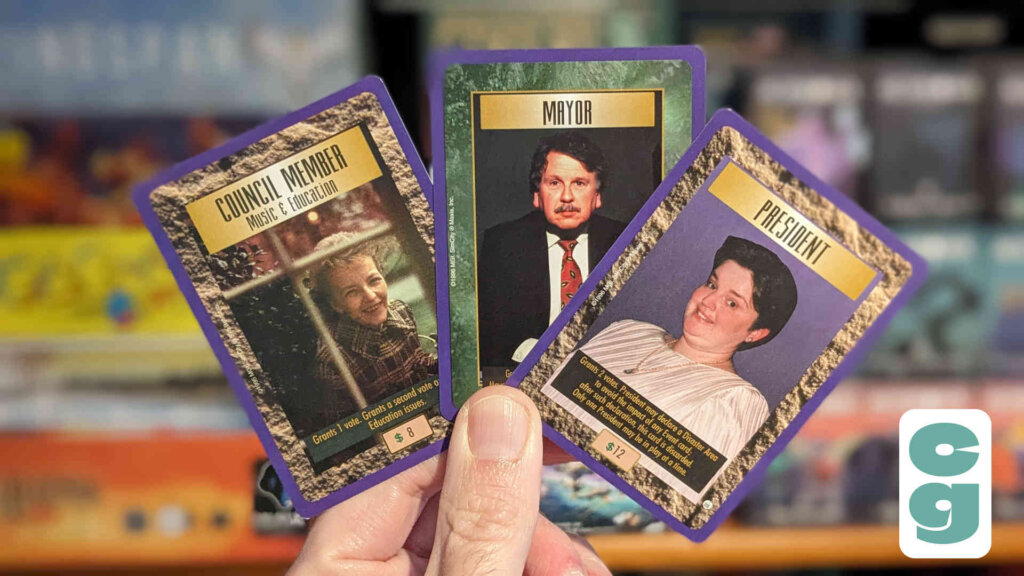
One of the most interesting elements of Sim City: The Card Game is the City Council.
As mentioned above, the player who places the Power Plant and kickstarts the City phase of the game immediately becomes the Mayor.
All but pink phase cards become available to play and other players can spend their cash on becoming City Council officials.

The most common are Council Members which cost $5 (that value is explained as being the money needed to run their campaign for election!); these allow players a vote when rezoning blocks in the city. The Mayor can break ties and their vote is worth double that of a standard Council Member too!
Players are free to make deals, financial or otherwise, in order to sway other councillors to vote for their plans.
There’s even Corrupt Council Members who will only vote for their specific zone type, or against the rezoning of a block if it means losing that zone type.
The Council is a genuinely excellent aspect of the game and one that does seem to be really well implemented too, allowing players to collaborate for their own benefit or backstab each other to remain on top!
Double Length Cards
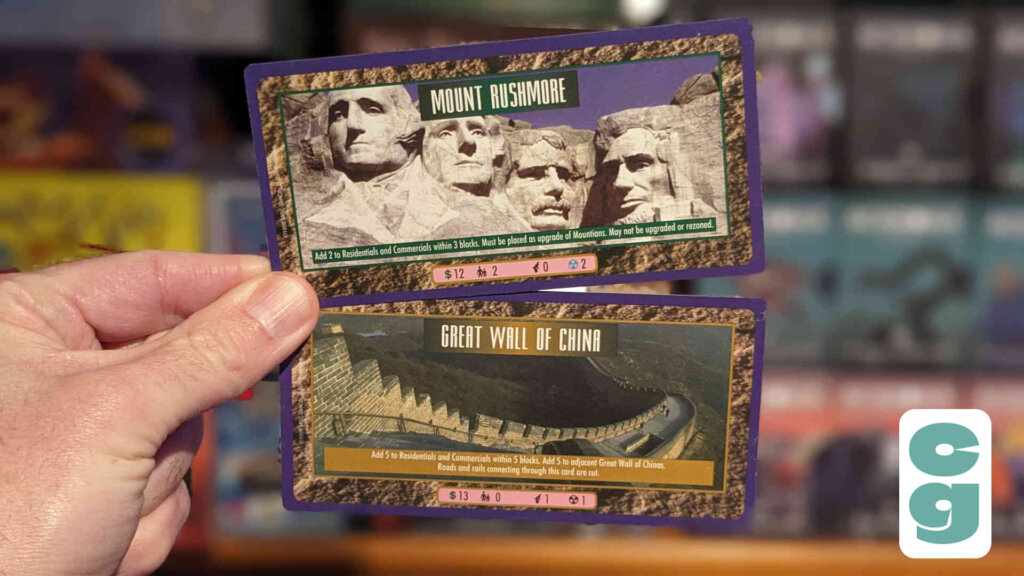
One of the most unique aspects of Sim City: The Card Game are the double length cards.
You’ll notice that booster packs are much longer than those found in other games; this is because each one contains an ultra rare, double length card.
These cards are shuffled and separated into their own deck at the beginning of the game placed on top of two existing cards (never on an open space) to rezone them and count as one city block.
They’re often very valuable in-game and can represent famous landmarks, as you can see from the cards we have!
Deck Building In Sim City
Another really interesting element of Sim City: The Card Game is the fact that all players play from the same deck.
Unlike other CCGs, in which players must all have their own deck, custom built or otherwise, in Sim City everyone draws from a single deck of cards.
The rules to build decks are in character with the rest of the Sim City rule book, in that they don’t really go into enough detail to help burgeoning city planners put their selection of cards together.
For example, the rules state that decks should be formed of around 25-30 cards per player but doesn’t offer any assistance at all in recommending what type of cards should be included.
However, if you have experience of building decks in other CCGs, you’ll likely not have too much of a problem building decks for Sim City.
For example, you know you’ll need quite a few Sim-providing cards that can be used for the Settlement phase, otherwise you’ll be stuck with lots of cards you can’t use during the early stages.
Try to include some of the more powerful cards for Phase III and IV, but keep them to a minimum as not only will they only prove useful towards the end of the game, but there’s also a chance that players will be vetoed when trying to use them anyway!
Also, make sure that you’re including cards which can take advantage of their special bonuses when you’re building; if a card mentions other city blocks that it’ll get bonuses from when played, include that card too.
The shared deck aspect does mean that only one person needs to build a deck though, which cuts down the time investment from other players, who just need to show up!
Despite the rules being rather unhelpful with building decks, I actually found it to be pretty addictive in its own right.
The fact that you’re pre-planning what features and buildings can go towards creating your city during the deck building process is really compelling.
For example, you might want a more rural city, with lots of farmland and forests, with minimal urbanisation. Or a big capital city, with lots of governmental buildings and landmarks. Even a college town with lots of educational institutions; there’s lots of leeway to build the deck the way you want to, with very few restrictions.
Though this means you need to be careful not to build a deck that’s impractical to play (don’t forget to include Power Plants if you want to get to Phase III and beyond!), it still leaves you with a lot of options depending on the cards you have available.
Playing Solitaire Sim City
Of course, there’s also the option of playing Sim City: The Card Game as a single player experience.
Having tried this, I can highly recommend it; both the deck building and game itself feels like a really compelling puzzle when tackled on your own; though the aim isn’t to get to $250, it’s a target I’ve managed to reach in my own single player games.
It’s well worth getting hold of a Starter Deck to give this a shot, so you won’t even have to worry about deck building to try this out.
Which leads us on to the next point!
Buying Cards For Sim City
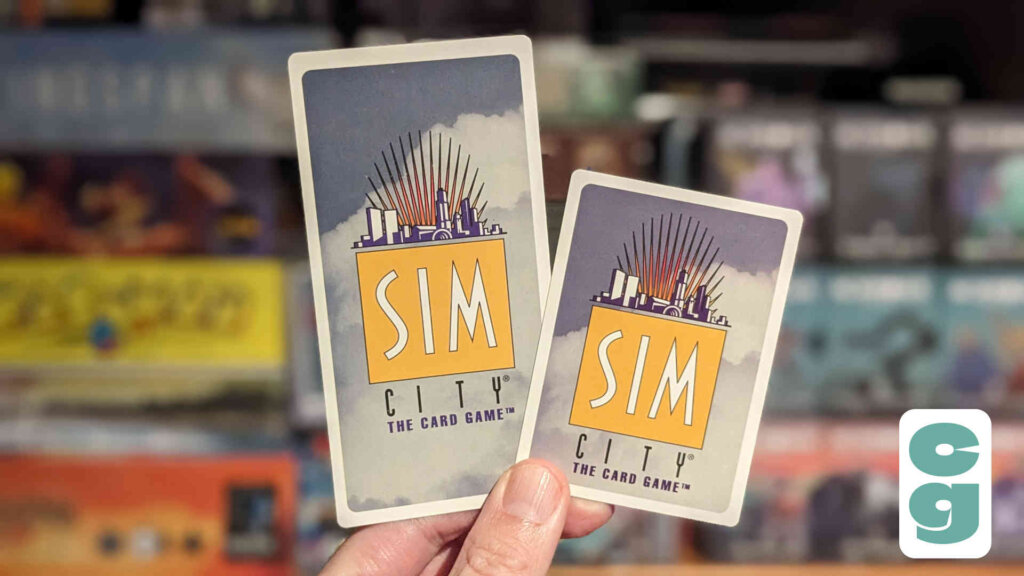
When Sim City was first released, both starter decks and boosters were available.
Long cards were only available in booster packs, giving players an incentive to explore beyond the cards included in starter sets.
Special sets based on real cities were released too, with Chicago, New York City and Washington DC all providing balanced, interesting recreations of genuine places (at least as they were in the mid-90s!).
When building my first deck, I used a selection of cards from my Washington DC set, to create a sort of small US governmental city!
Cards tend to be pretty widely available, with sealed packs of boosters and starters not being difficult to find at all on eBay.
They’re also pretty cheap, so if you do want to go ahead and get yourself a decent collection of cards, it won’t cost the earth!
The Card Gamer Verdict On Sim City: The Card Game
So is it worth buying and playing Sim City: The Card Game, nearly 30 years after it was released?
Despite the issues with its rules (and the rather ugly, dated looking cards) if you can get over the initial hurdle of learning to play, Sim City: The Card Game, we say yes.
Its nature as a non-fantasy, non-sci fi and non-combat based CCG (aside from the City Council voting and vetoing, which can get a bit heated!) truly sets it apart from any other collectable card game that came before or since, even three decades later.
It’s not quite co-operative, but it’s also nowhere near as competitive as other CCGs, plus the single deck per game, rather than per player, also adds to its appeal and cost effective nature.
If you’re a curious fan of the Sim City video games or a CCG fan looking for a unique experience, Sim City: The Card Game absolutely, and surprisingly, delivers.
It’s a shame that it didn’t do well enough to see the release of further expansions and dedicated city sets (which were planned), but its commercial failure does mean that it’s a cheap game to get into and collect even now, nearly three decades on!


